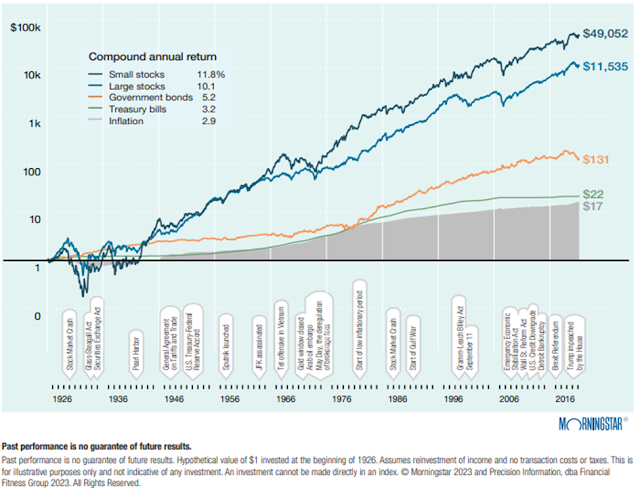I wanted to present some general discussion about fixed income securities. I will then present the companies I invested in this week, followed by a detailed review of each at the end of the newsletter. I included this commentary in the March 2023 Dividend Growth Investor Newsletter. I originally used Treasury Bills, but edited to Certificates of Deposit here.
For the past 15 years, we’ve had falling or low interest
rates in the US. The last time I could buy a Certificate of Deposit (CD) yielding
5% was in 2008. Today, after 15 years, I could buy a Certificate of Deposit yielding 5%. I could theoretically lock money for up to 2 years at 5%/year
using a Certificated of Deposit.
Naturally, I see some investors gravitating towards fixed
income.
I see nothing wrong with owning some fixed income
instruments, especially for short-term savings needs such as having your
emergency fund, or saving for a major purchase within the next say 1 - 2 or 3
years. It may make sense for some older investors as well, especially if they
have lower risk tolerance.
With Bonds, you are guaranteed to get your original
principal back and you are guaranteed to earn your interest as well. We are
going to assume you hold through the maturity date. Otherwise, you may end up
losing money under some scenarios (if interest rates increase after you buy the
bond). You may also end up making money if you sell early (if interest rates
decrease after you buy the bond).
However, the downside of fixed income instruments is that
they are fixed in terms of yield and term. This means that at the end of your
term (when the bond expires), you would have to acquire another bond. However,
we do not know today if those yields would be higher or lower. In addition, your return is limited to the
interest rate you settled on at the time of purchasing that bond. It would
never increase, though you are guaranteed to get your principal back at
maturity.
The other risk is that these fixed income instruments offer
high nominal yields, but that doesn’t really tell you much about the real
yields after inflation. A bond yielding 5% sounds nice, but is not as cool if
inflation is more than 5%. In that case, you are losing real purchasing power
for your principal AND income.
A third issue is that interest income on bonds is full
taxable at ordinary tax rates. Treasury Bonds are exempt from state income
taxes, though interest on CD’s is taxable at the State and Federal level. That
could be avoided by buying them through a retirement account.
The fourth issue is reinvestment risk. One can buy a 1 year
or 2-year Certificate of Deposit yielding 5% today. They are guaranteed that rate for
the duration of the bond. At maturity however, they have to reinvest at the
going rate. That rate could be higher or lower. Over the next decade, that’s
several reinvestment risk scenarios out there. There is not a high likelihood
that Short-term Bond would generate 5% annualized returns over the
next decade. Investors could theoretically buy a 10 year Bond yielding 4%.
However, the issue is that their coupon would not increase. In addition, the
purchasing power of their principal and income would slowly lose value over
time.
With dividend growth stocks, you may be getting a lower
yield today, but there is a decent chance that over a longer period of time
that dividend income will grow at or above the rate of inflation. This helps
preserve and even increase purchasing power of that passive income. In
addition, there is the opportunity to generate capital gains as well, as those
businesses earn more money and distribute more to shareholders over time. Of
course, nothing is guaranteed and there is risk, but if history is any guide,
it is possible that a diversified portfolio of dividend growth stocks would be
generating a higher income in 10 or 20 or 30 years from, while also being
valued at higher prices over that same time period. Purchasing A bond that
yields 4% that expires in a decade would yield income that doesn’t grow and a
value that doesn’t change at maturity.
In addition, I wanted to share a longer-term view of total
returns on US Equities, Bonds and Short-term bills between 1926 and 2022:
I believe that a long-term investor in equities over the
next 10 – 20 - 30 years would do better than an investor in fixed income like
T-Bills or Certificates of Deposit. A diversified dividend growth portfolio would likely generate much
higher future yields on cost and total returns over the next 10 - 20 - 30
years. A bond portfolio would not.
I understand the logic to hold fixed income for items such
as an emergency fund, or if someone is saving for a particular large expense
over the next 1 – 3 years for example. In that case, using bonds or a savings
account seem like a good idea. However, I would discourage folks who are buying
Treasury Bills or Certificates of Deposit in an attempt to try and to time the market.
Relevant Articles:
- Does Fixed Income Allocation Make Sense for Dividend Investors Today?

